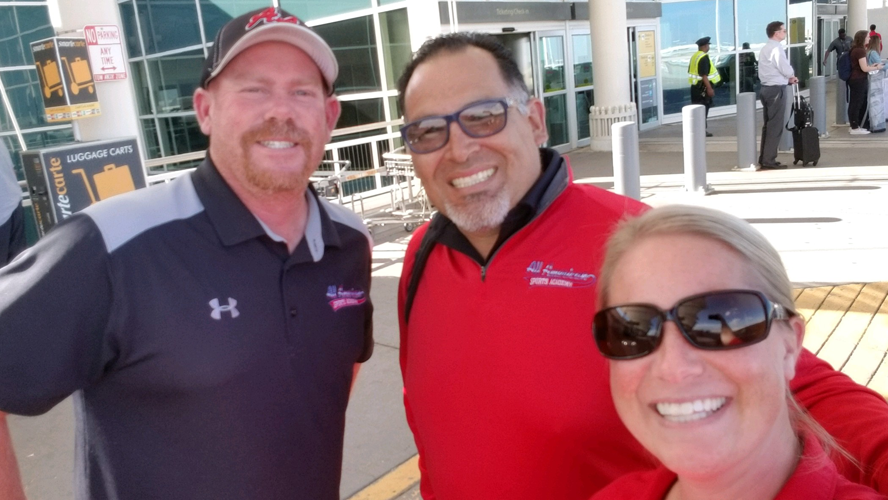|
The All-American Sports Academy sprang to life through the vision of fastpitch coaching icon Debbie Nelson, who founded the Northern California enterprise 21 years ago. The past 14 years have seen the AASA start and sustain travel teams in softball, showing plenty of muscle in tournament settings and deepening the pool of talented players filling college rosters – the 18 Gold squad is typically one of the strongest rosters in the country (and will play in our Sparkler/Fireworks tournament in 2019). AASA was the fastpitch home of Washington All-American and Team USA member Ali Aguilar.
AASA officials/coaches Jaime Jimenez and Charlie Pikas made the trip to Triple Crown’s offices in mid-September and stopped to share some thoughts and perspectives on their club and the shape of the sport. What do you want to make sure parents and players understand about AASA before they suit up for you? JJ: In the very beginning, our priorities were to put kids in college, to give them an opportunity to further their education and play. That was always a starting point that led us to where we are now. We’ve got quite a few college players in our alumni list now, which is pretty cool. CP: We ask parents to support their athletes. It’s not easy playing at the level we try to have our teams play at, so there’s a lot of support needed, most obviously the financial (aspect) and the time. But it’s the mental support, and the physical support of a hug after the tournament. We want them to compete at a high level, and the parents need to get that going in. It’s going to take time away from family vacations in the summer, but your window to be on the journey with these kids is not very long. In the moment, it might seem like you’re giving up a lot, but then you look back and it’s done. The game has evolved so much in the 14 years you all have played travel ball; what jumps out the most about the players in that time? JJ: You’re seeing kids who are in way better shape; they seek out personal trainers, hitting coaches and pitching coaches, more than they did back then. The level of play is so much better with kids starting younger, and we also like the fact they play other sports to be well-rounded. You are a better softball player when you play basketball or field hockey or whatever. But really, the training out there has been a big difference maker in our sport. There aren’t any barriers. CP: It’s what they are capable of … when I started coaching 20 years ago, it felt like fine china, and you didn’t want to break the kids. “Let the girls play, and it’s so cute to watch them…” now, it’s more exciting for me to watch a softball game than a baseball game. What these kids are able to do by allowing them to go out and push themselves and play at that level, it’s exciting. The game is taking off at a great rate, and we hope it continues like that. How do you approach the question of trying to win, while also making sure you are developing players properly? JJ: A lot of my younger teams will hear me say, I’m not that concerned about you winning games. What I’m concerned about is the development; when the winning time comes, usually around when they are 14s or 16s, winning helps the health of the franchise. But you still want to produce terrific kids. It’s a relief you see on the faces of the coaches for our younger kids when I say I’m not worried about you winning. What I want is for them to grow, so when they go to the next age group they can compete, and they’ll keep competing. Winning will come after all the hard work we all put in. It’s a recipe that will work if you trust it and follow it. CP: “Trust the process” is the big catch-phrase right now, but you really have to get parents to understand what your team is, what level you are at and where you’re trying to go, and that they need to be realistic. You lay out that road map in the beginning, and keep that open line of communication going along the way, they can get through the tough times. It’s those coaches who have sole emphasis on winning and you see them get beat down after two or three tough weekends in a row … it starts to affect the team, and then you get parents who are frustrated. So you help the parents along the way, not just the kids, so they all can weather the storm. If a player has a slump in a tournament, it’s not like we are going to give up on that kid, so if we have a tournament where things don’t go well, it’s the same thing. What are some of the goals for AASA heading into the 2019 campaign? JJ: The first thing that’s got us excited is having a 10u team in Seattle; the second part is, I’m completely bought into our youth teams right now. We have some strong young teams, and that’s the future for us at a high-level way. Our older teams are always competing, but we’ve always struggled in the younger ages and I think we’ve cleared that hurdle and will really surprise some people. CP: There’s some transition at the 18 Gold level where we’re seeing some new faces. There’s stuff to be excited about at every level, with some different expectations and excitement levels. On a softball field, there’s a lot that can happen – accurate pitches, solid hits, speeding fielders all playing out backed by a soundtrack of claps and hoots, with the loudest of cheers and the quietest of strategy-centric whispers filling the gaps.
That’s key, really, the space a softball field makes available for anyone who wants to cross the lines. And not only can young women simply take pleasure in playing a game, but they can find encouragement to seize an opening in their own lives. When it’s really clicking for the Oregon Blaze fastpitch program, based near Portland, the sport of softball is more than an arena for breaking a sweat. From its start in Beaverton nearly 30 years ago, when Jim Marron and Lynn Buerer held a tryout and got blitzed by nearly three dozen 8-year-olds showing up, to today’s high-achieving crew of about 12-15 squads depending on the season, the Blaze wanted to solve problems and be a force for physical and personal development. “In 1989 my daughter was born; she played T-Ball at age 6, and at age 7, Lynn Buerer and I decided it was time to even the playing field with softball. We called ourselves the Angels the first year; 35 kids showed for the first tryout,” Marron said. “We thought, we can’t leave all these kids out here and we wanted to give them an opportunity to play this great game. Next year, we formed the Beaverton Blaze, two teams, 10A and 10B. Most players were age 8 and 9; we wanted to maybe play a couple years and then be ready to function as a more competitive organization. “The following year, 1998, we had three teams, 12A, 10A and 10B. The 10A team went 94-7 and played in the ASA National tourney in Broken Arrow, OK. We thought, if you’re playing on Saturday you did well, and we felt we did pretty well. Testing the waters like that at 10u was probably over-ambitious. Half the team was 9, a couple 8-year-olds … we had set a goal to qualify for Nationals, hell or high water. We said the more games we played, the better our situation would be. We started in late March and played into August. We were the team, people hated to see show up – it was always going to be tough to get through us.” Mic Bowman, coach of the 18 Gold and 16 Gold feeder squad, got involved in 2000 when the softball world he saw lacked stability and focus. Sensing a huge opportunity was being frittered away for his daughters, Bowman immersed himself in the sport and relied on his enthusiasm for the game to provide what he couldn’t pull off because of experience. “Around 2000, our Little League (softball) was having political issues, and I decided I didn’t want to be the parent who just complains, so I did something about it. I spent six months, literally, watching videos,” Bowman said. “I taught myself how to pitch, I went to pitching clinics, and I got familiar with travel ball coaches in the area … call it a six-month crash course on all things softball. When my oldest daughter was 9 or 10, I started coaching. “The thing that has kept me going is seeing how much social pressure is being applied to young women to fit in some mold of acceptable behavior. That’s kind of pissed me off at the time. I wanted to do my best to prepare young women, not for any particular future but for the ability to choose their own future. To be a stay-at-home mom, or a corporate career person, all independent of the shape society wanted to put them in. This game gives a way to learn so many life lessons – dealing with failure, persistence, the value of hard work, teamwork, so many things – it seemed like a great opportunity. And even when my kids were done playing, it felt like the right way to give back.” Oregon may sound like an athletic outpost, but the quality of softball players from the area continues to impress. For the Blaze, it begins with patience and a welcoming vibe in the early ages and is fortified with a desire to keep parents, players and coaches mindful of the long-term goal. That goal might include a college scholarship, but the Blaze wouldn’t want to focus exclusively on that result. “I started with younger teams, 10u and the like, and we didn’t travel, we stayed in the region. Fastpitch is a very big sport here,” said Blaze director James Lambert. “We host the Little League Softball World Series. We get a berth for hosting, and it’s a starting point for younger girls and helping us with numbers, and that’s big because there is pressure coming from soccer and lacrosse. The families that like it and want more tend to come over to the Blaze.” “At the time, the softball wasn’t that great as a whole. We did identify that there were good players (in multiple leagues),” Marron said. “We wanted a structure so those players could get together and play in an advanced environment, and so we had to travel and find good teams to play. It got to a point where we could see other good softball teams in the area, as they had seen it could work. We were all about skill development and playing the game well – what teamwork means, and how to be strong in the mental part of the game. I spent 11 years going to an Arizona camp for skills and training insight. We valued forming good teams that got along, minimizing the drama.” With that foundation, the Blaze moved ahead and started to address the gap that existed in terms of experience and game savvy with competitors from softball hotbeds like California, Texas and the Southeast. Some of those matchups didn’t end up well in the younger age groups (that’s not a shock, given the state might get four months of solid sunshine a year), but as players got older, the differences at 16u and 18u began to shrink. In fact, that’s one reason why the Blaze is enthused about recent changes in college recruiting, because an Oregon player may look a bit green and unrefined at age 12 or 14. Another dose of competition and seasoning is exactly what the talent in Oregon thrive upon. And in that thriving, the deeper usefulness of the sport can emerge. “With competitiveness and things like that … it’s not the goal, but a means to achieve the goal. The ability to have enough confidence in yourself that no matter how many times somebody has told you what you have to do, you can figure out the right thing and then do it,” Bowman said. “The willingness to put in the work, to sacrifice, to see that if I spend three nights a week in the gym during January, it pays off in April and May … doing the grunt work to be ready for the glory. It’s a lesson that applies for everyone. “To understand what it takes to be a softball coach, there’s no other sport remotely close, other than baseball, that has this visibility and focus on failure. You miss a shot in basketball, you try to get a rebound, but you’re part of 10 people continuously moving. In the batter’s box, everyone is looking at you, and success and failure is singular to you as an individual. If you let it beat you, if you let the fear of failure beat you, then you’re in trouble. I see a direct tie in how much you are willing to believe and commit to your instincts and the success you have, and it’s very immediate. There’s clarity not about your ability, but your ability to fight back.” The modern age of softball is not short on challenges to the aspirations of the Blaze – some years, that aforementioned hunger for scholarships can wobble a team’s focus, and there are parents who lack that certain “off” switch when it comes to behavior in the stands. But the positive results and meaningful changes within the players are much more plentiful and memorable. “Every collection of players is different. We’ve had times with a group of players that was so focused on the recruiting side of things that is was very difficult to get any cohesion … those are years where we might win a lot of games, but it’s still very frustrating,” Bowman added. “Or we may have a group that plays together wonderfully as a team, and they don’t win as much because they are not as talented. It’s true – my motivation is to teach the kids, to allow them to express their passion for the game at the highest level they possibly can. “We do our absolute best to aid the kids. Our approach to recruiting is a little different – we don’t come in and say we’ll get you a scholarship. We say, you’ll get the scholarship, and we are here to help and train. We communicate with college coaches, and I get behind the backstop and talk to college coaches, but it’s on behalf of the kids. The responsibility for recruiting is on the players, while the coaching staff facilitates and helps with connections.” Up in the corner of the country, the Oregon Blaze knows the right angle to take. |
Archives |


 RSS Feed
RSS Feed
